Stainless steel pans gleam like beacons of culinary prowess in our kitchens, promising perfectly seared meats, flawlessly sautéed veggies, and sauces that dance with flavor.
Yet, behind their lustrous facade often lurks a challenge: the aftermath of cooking. Fear not, for in the delicate dance of culinary finesse, knowing how to clean stainless steel pans is the virtuoso’s secret.
With the right techniques, these kitchen workhorses can be restored to their former glory, ready to embark on another gastronomic adventure.
Prepare to unveil the shimmering potential of your stainless steel companions as we delve into the art and science of pristine pan perfection.
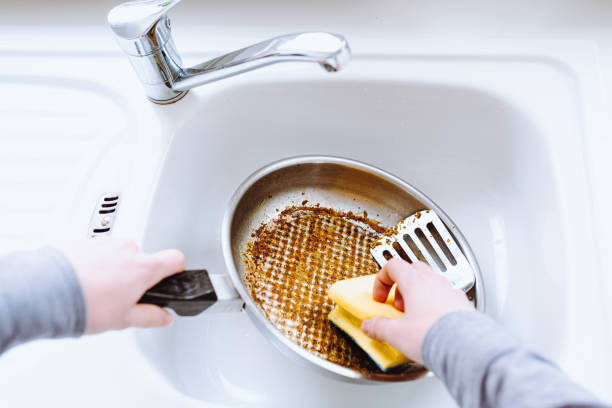
How To Clean Stainless Steel Pans
Cleaning stainless steel pans can be a breeze with the right methods at your disposal. Whether you’re dealing with burnt-on food residue or stubborn stains, there are numerous techniques you can employ to restore your pans to their former glory.
From utilizing common household items to specialty stainless steel cleaners, the options are vast. By understanding and implementing these 13 methods effectively, you can ensure that your stainless steel pans remain in pristine condition for years to come.
Let’s dive into each method and explore the best ways to keep your cookware sparkling clean.
1. Heat The Pan
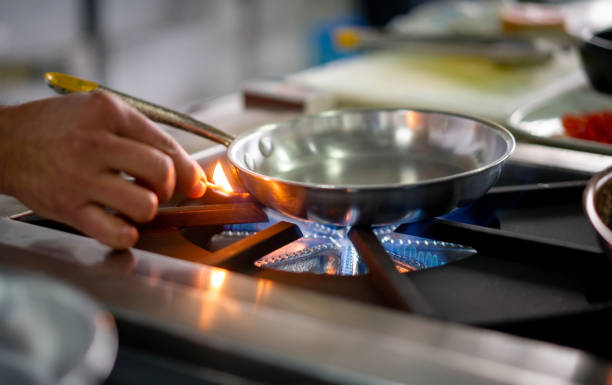
Before diving into any cleaning process, it’s essential to begin by heating the stainless steel pan. This step helps to loosen any stuck-on food particles or grease, making them easier to remove later on.
Start by placing the pan on the stove over medium heat. Allow it to warm up gradually, ensuring that the entire surface area of the pan is heated evenly.
This process also helps to open up the pores of the stainless steel, making it more receptive to cleaning agents. Depending on the extent of the residue, you may want to heat the pan for a few minutes until it’s warm to the touch.
Be cautious not to overheat the pan, as excessive heat can cause discoloration or damage to the stainless steel surface. Once adequately heated, the pan is primed and ready for the next cleaning steps.
2. Soapy Water

After heating the stainless steel pan, the next step is to prepare a solution of warm, soapy water. Fill the sink or a basin with hot water and add a generous amount of dish soap. Swirl the water to create suds, ensuring that the soap is evenly distributed.
Then, carefully place the heated pan into the soapy water, ensuring that it is fully submerged. Allow the pan to soak for at least 15 to 20 minutes. During this time, the warm, soapy water works to further loosen any remaining food particles or grease from the pan’s surface.
Moreover, the detergent helps to break down stubborn stains, making them easier to remove. This gentle soaking process is effective for preparing the pan for more targeted cleaning methods later on.
Once the soaking time is complete, remove the pan from the soapy water and proceed to the next step in the cleaning process.
3. White Vinegar

After soaking the stainless steel pan in warm, soapy water, another effective cleaning method involves using white vinegar. White vinegar’s acidic properties make it a powerful agent for breaking down tough stains and residue.
To utilize white vinegar for cleaning, begin by draining the soapy water from the sink or basin. Next, rinse the pan thoroughly under warm running water to remove any loose debris.
Then, pour a generous amount of white vinegar directly onto the surface of the pan, ensuring that it covers any stubborn spots or stains. You can also dilute the vinegar with water if desired, although full-strength vinegar is often more effective for tough cleaning tasks.
Allow the vinegar to sit on the pan’s surface for a few minutes, allowing it to penetrate and dissolve any remaining residue. For particularly stubborn stains, you can gently scrub the pan with a sponge or scrubbing pad while the vinegar is still applied.
Once the stains are lifted, rinse the pan thoroughly with warm water to remove any vinegar residue. This method effectively eliminates stubborn stains and restores the stainless steel pan to its original shine.
4. Baking Soda
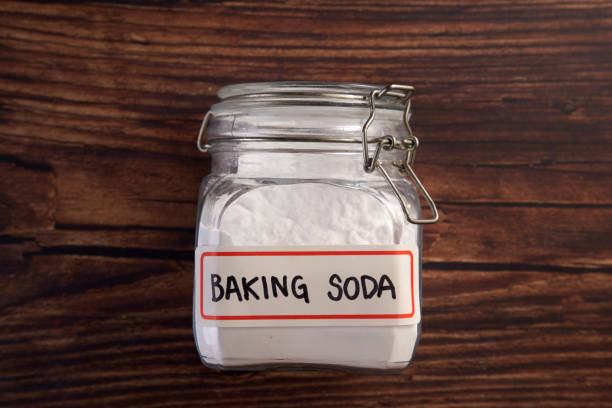
Baking soda is a versatile and gentle abrasive that can effectively clean stainless steel pans without scratching the surface. To begin, sprinkle a generous amount of baking soda onto the surface of the pan, focusing on areas with stubborn stains or burnt-on residue.
Next, add a small amount of water to create a paste-like consistency, using a spoon or your fingers to mix the baking soda and water together. Once the paste is formed, apply it to the surface of the pan, spreading it evenly over the stained areas.
Allow the baking soda paste to sit on the pan for about 10 to 15 minutes, allowing it to penetrate and break down the residue. During this time, the baking soda works to lift stains and absorb odors, leaving the pan fresh and clean.
After the designated time has passed, use a soft sponge or cloth to gently scrub the surface of the pan, focusing on areas with tough stains. The mild abrasive action of the baking soda helps to loosen and remove stubborn residue without causing damage to the stainless steel surface.
Once the stains are lifted, rinse the pan thoroughly with warm water to remove any remaining baking soda residue. This method is highly effective for restoring the shine and cleanliness of stainless steel pans without the need for harsh chemicals.
5. Lemon Juice
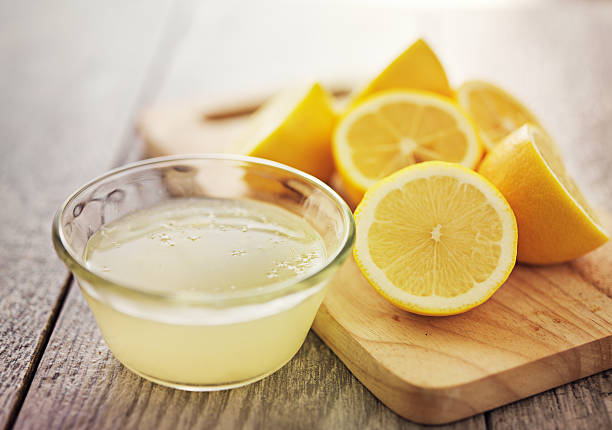
Lemon juice is another natural and effective cleaner for stainless steel pans, thanks to its acidic properties and pleasant citrus scent. To utilize lemon juice for cleaning, begin by cutting a fresh lemon in half.
Squeeze the juice from one or both halves, depending on the size of the pan and the severity of the stains. Alternatively, you can use bottled lemon juice if fresh lemons are not available.
Next, pour the lemon juice directly onto the surface of the pan, ensuring that it covers any areas with stubborn stains or discoloration. Allow the lemon juice to sit on the pan for about 5 to 10 minutes, giving it time to penetrate and break down the residue.
During this time, the acidic nature of the lemon juice helps to dissolve grease and lift stains, making them easier to remove. After the designated time has passed, use a soft sponge or cloth to gently scrub the surface of the pan, focusing on areas with tough stains.
The natural acidity of the lemon juice enhances the cleaning process, leaving the stainless steel pan sparkling clean and refreshed. Once the stains are lifted, rinse the pan thoroughly with warm water to remove any remaining lemon juice residue.
This method is safe, eco-friendly, and highly effective for maintaining the shine and cleanliness of stainless steel pans.
6. Salt And Lime
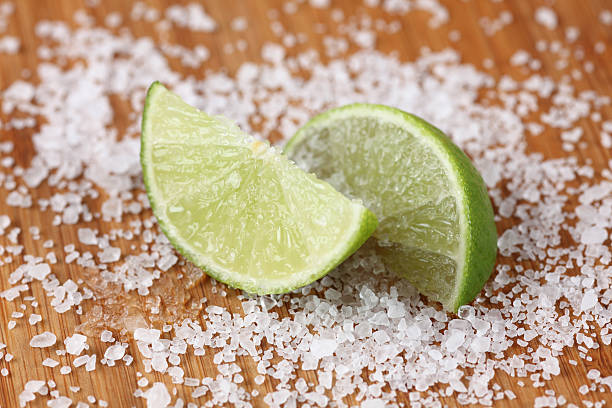
Salt and lime are a dynamic duo when it comes to cleaning stainless steel pans, offering both abrasive and acidic properties to tackle tough stains and residue. To begin, sprinkle a generous amount of coarse salt onto the surface of the pan.
Coarse salt works best for this method as it provides effective abrasion without scratching the stainless steel surface. Next, cut a fresh lime in half and squeeze the juice onto the salt-covered surface of the pan.
The acidic juice of the lime reacts with the salt to create a powerful cleaning paste. Use the lime halves to rub the salt and juice mixture into the stained areas of the pan, applying gentle pressure as needed to loosen stubborn residue.
The abrasive action of the salt helps to lift stains, while the acidity of the lime juice breaks down grease and grime. Continue rubbing the salt and lime mixture onto the pan until you’ve covered all stained areas.
Allow the mixture to sit on the pan for a few minutes, allowing it to penetrate and work its magic. After the designated time has passed, use a soft sponge or cloth to scrub the surface of the pan, focusing on areas with tough stains.
Rinse the pan thoroughly with warm water to remove any remaining salt and lime residue, revealing a clean and shiny stainless steel surface. This natural cleaning method is both effective and environmentally friendly, making it an excellent choice for maintaining the cleanliness of your stainless steel pans.
7. Flour
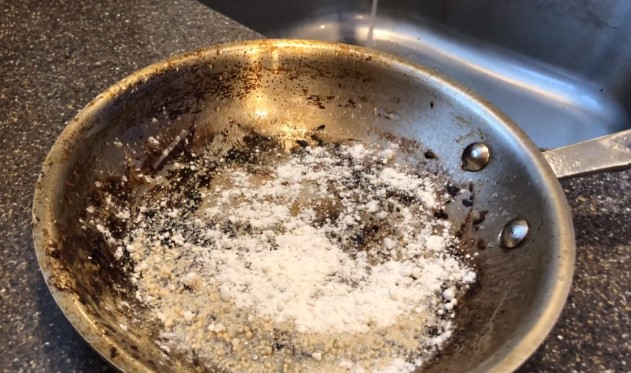
Flour might seem like an unlikely candidate for cleaning stainless steel pans, but its absorbent properties make it surprisingly effective, especially for oily residue. To start, sprinkle a liberal amount of all-purpose flour onto the surface of the pan, focusing on areas with stubborn grease or food residue.
Use enough flour to create a thin layer covering the affected areas. Next, use a dry cloth or paper towel to gently rub the flour into the surface of the pan, applying light pressure to help it absorb the oils and lift the stains.
Allow the flour to sit on the pan for about 10 to 15 minutes, giving it time to absorb the grease and loosen stubborn residue. During this time, the flour works as a gentle abrasive, helping to lift stains without scratching the stainless steel surface.
After the designated time has passed, use a soft-bristled brush or sponge to scrub the surface of the pan, focusing on areas with tough stains. Rinse the pan thoroughly with warm water to remove any remaining flour residue, revealing a clean and shiny stainless steel surface.
This method is particularly useful for removing oily residue and is an excellent option for maintaining the cleanliness of your stainless steel pans.
8. Cream Of Tartar And Lemon Juice
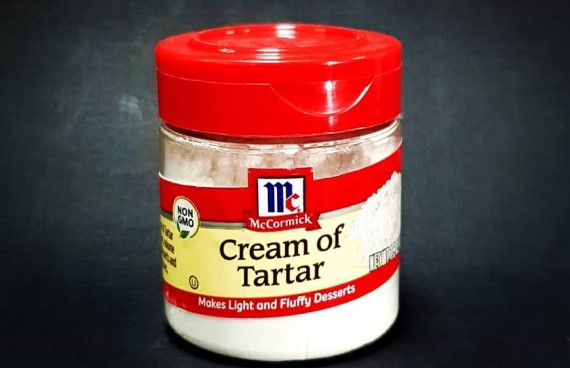
Cream of tartar combined with lemon juice creates a potent cleaning mixture that can effectively tackle stains and discoloration on stainless steel pans. To begin, mix equal parts cream of tartar and lemon juice in a small bowl to form a thick paste.
The acidic nature of the lemon juice, combined with the abrasive properties of the cream of tartar, creates a powerful cleaning agent. Apply the paste generously to the stained areas of the pan, ensuring even coverage.
Use a soft-bristled brush or sponge to gently scrub the surface of the pan, focusing on areas with tough stains. Allow the paste to sit on the pan for about 10 to 15 minutes, giving it time to penetrate and break down the residue.
During this time, the mixture works to lift stains and restore the shine of the stainless steel surface. After the designated time has passed, rinse the pan thoroughly with warm water to remove any remaining paste residue.
This method is highly effective for removing stubborn stains and is safe for use on stainless steel pans. Additionally, the natural ingredients make it an eco-friendly cleaning option.
9. Tomato Sauce, Ketchup, Or Crushed Tomatoes

Tomato-based products like tomato sauce, ketchup, or crushed tomatoes can be surprisingly effective for cleaning stainless steel pans, especially for removing tarnish and restoring shine.
To begin, apply a small amount of the tomato-based product directly onto the stained areas of the pan. Ensure that the product covers the stains adequately. The natural acidity in tomatoes helps to break down stains and lift them from the surface of the stainless steel.
Allow the tomato-based product to sit on the pan for approximately 10 to 15 minutes, allowing it enough time to work its magic. During this time, the acidic properties of the tomatoes penetrate the stains, making them easier to remove.
After the designated time has passed, use a soft-bristled brush or sponge to gently scrub the surface of the pan, focusing on areas with tough stains. The gentle abrasion, combined with the acidity of the tomatoes, helps to loosen and lift the stains effectively.
Rinse the pan thoroughly with warm water to remove any remaining tomato residue. This method is particularly useful for removing tarnish and restoring the shine of stainless steel pans, leaving them looking like new.
10. Club Soda Or Coca Cola
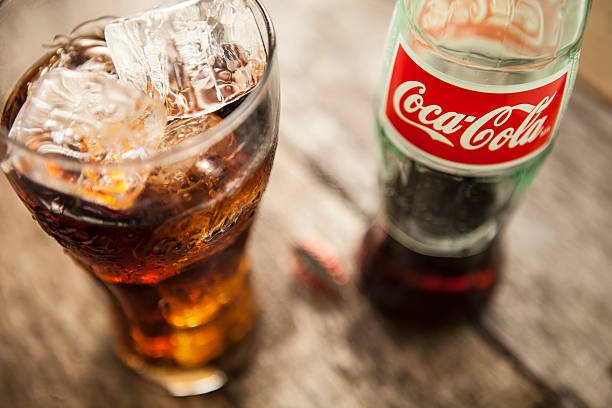
Club soda or Coca-Cola can be surprisingly effective for cleaning stainless steel pans, thanks to their acidic properties and effervescence. To start, pour a small amount of club soda or Coca-Cola directly onto the stained areas of the pan.
Ensure that the liquid covers the stains evenly. The acidity and carbonation in these beverages help to break down tough stains and lift them from the surface of the stainless steel.
Allow the club soda or Coca-Cola to sit on the pan for approximately 10 to 15 minutes, giving it enough time to penetrate the stains. During this time, the effervescence and acidity work together to loosen the stains, making them easier to remove.
After the designated time has passed, use a soft-bristled brush or sponge to gently scrub the surface of the pan, focusing on areas with stubborn stains. The gentle abrasion, combined with the acidity and carbonation, helps to lift the stains effectively.
Rinse the pan thoroughly with warm water to remove any remaining liquid residue. This method is particularly useful for removing tough stains and restoring the shine of stainless steel pans, leaving them looking clean and refreshed.
11. Salt, Baking Soda, And Toothpaste
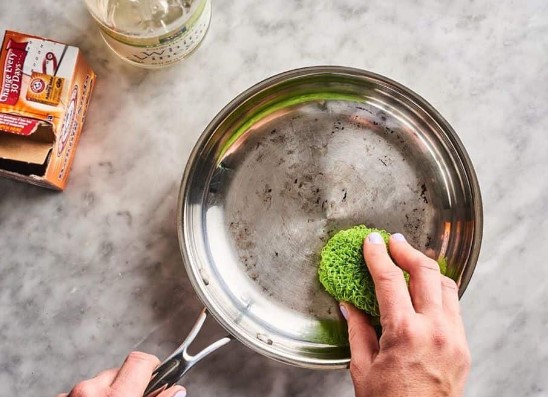
Combining salt, baking soda, and toothpaste creates a powerful cleaning mixture that can effectively remove stains and restore the shine of stainless steel pans. To begin, mix equal parts of salt and baking soda in a small bowl.
Add a small amount of toothpaste to the mixture and stir until a thick paste is formed. The abrasive properties of the salt and baking soda, combined with the cleaning agents in the toothpaste, create a potent cleaning solution.
Apply the paste generously to the stained areas of the pan, ensuring even coverage. Use a soft-bristled brush or sponge to gently scrub the surface of the pan, focusing on areas with tough stains.
The gentle abrasion, combined with the cleaning agents in the toothpaste, helps to lift stains effectively. Allow the paste to sit on the pan for approximately 10 to 15 minutes, giving it enough time to penetrate the stains.
After the designated time has passed, rinse the pan thoroughly with warm water to remove any remaining paste residue. This method is highly effective for removing stubborn stains and restoring the shine of stainless steel pans, leaving them looking clean and refreshed.
12. Commercial Cleaners
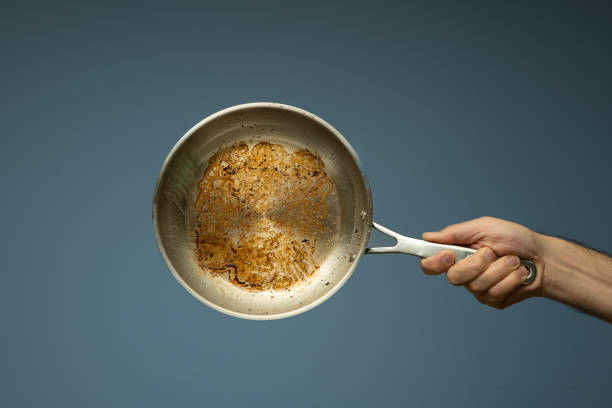
Commercial cleaners specifically designed for stainless steel are readily available and can be highly effective for cleaning stainless steel pans.
These cleaners often come in the form of sprays or creams and contain ingredients tailored to dissolve grease, remove stains, and restore shine without damaging the stainless steel surface.
To use a commercial cleaner, simply follow the manufacturer’s instructions on the product label. Typically, you’ll apply the cleaner directly to the stained areas of the pan, allow it to sit for a specified amount of time to penetrate the stains, and then wipe it away with a clean cloth or sponge.
Some commercial cleaners may require rinsing with water after application, while others may not. Always read and follow the instructions provided by the manufacturer to ensure optimal results and to avoid any potential damage to your stainless steel pans.
Commercial cleaners are convenient and can be an excellent option for tackling tough stains and maintaining the appearance of your stainless steel cookware.
13. Abrasive Pads
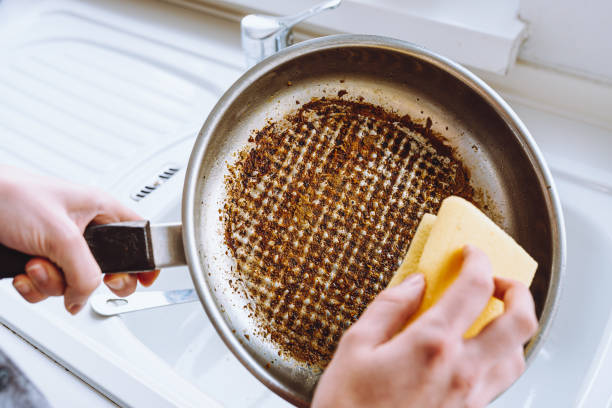
Abrasive pads, such as steel wool or nylon scrubbing pads, can be effective for tackling stubborn stains and burnt-on residue on stainless steel pans. These pads provide a rough texture that helps to scrub away tough stains without scratching the surface of the pan.
To use abrasive pads, wet the pad with warm water and apply a small amount of dish soap or a cleaning agent directly to the pad. Gently scrub the surface of the pan with the abrasive pad, focusing on areas with stubborn stains or residue.
Use circular motions and apply light to moderate pressure as needed to lift the stains. Be cautious not to scrub too vigorously, as excessive pressure could potentially scratch the stainless steel surface.
Rinse the pan thoroughly with warm water after scrubbing to remove any remaining residue. Abrasive pads can be an effective tool for deep cleaning stainless steel pans, but they should be used with care to avoid causing damage to the pan’s surface.
Always test a small, inconspicuous area of the pan first before using abrasive pads more extensively.
Frequently Asked Questions (FAQs) – How To Clean Stainless Steel Pans
Q: How can I maintain the gleaming appearance of my stainless steel pans?
A: Keep your stainless steel pans looking immaculate by following simple cleaning techniques outlined in our FAQs.
Q: Are there eco-friendly methods to clean stainless steel pans?
A: Yes! Discover environmentally conscious ways to maintain your stainless steel pans without harmful chemicals.
Q: Can I use everyday household items to clean my stainless steel pans?
A: Absolutely! Learn about common kitchen staples that double up as effective cleaners for your stainless steel cookware.
Q: What’s the secret to removing tough stains from stainless steel pans?
A: Unlock the power of gentle yet potent cleaning solutions to banish stubborn stains from your cherished stainless steel pans.
Q: Is it possible to restore the shine to dull stainless steel pans?
A: Revitalize your dull stainless steel pans with expert tips and tricks to bring back their lustrous shine effortlessly.
Q: How do I prevent discoloration on my stainless steel pans?
A: Shield your stainless steel pans from unsightly discoloration with preventative measures outlined in our FAQs.
Q: Can cleaning stainless steel pans be a stress-free task?
A: Absolutely! Discover hassle-free methods to keep your stainless steel pans spotless and gleaming with minimal effort.
Q: What’s the best way to maintain the longevity of my stainless steel pans?
A: Extend the lifespan of your stainless steel pans with proper care techniques shared in our FAQs, ensuring they remain kitchen essentials for years to come.
Q: Are there any unconventional methods to clean stainless steel pans?
A: Explore unique and innovative approaches to cleaning stainless steel pans that may surprise you with their effectiveness.
Q: Can cleaning stainless steel pans be a therapeutic experience?
A: Turn mundane chores into enjoyable tasks with our expert tips for cleaning stainless steel pans, making it a therapeutic and satisfying endeavor.
Conclusion
In conclusion, mastering the art of cleaning stainless steel pans is not only about preserving their sleek appearance but also ensuring their longevity and optimal performance in the kitchen.
By following the steps outlined in this guide, including using gentle yet effective cleaning agents, employing the right tools and techniques, and adopting regular maintenance practices, one can uphold the shine and integrity of their stainless steel pans for years to come.
Embracing these methods not only simplifies the cleaning process but also enhances the overall cooking experience, empowering individuals to create delicious meals with confidence and ease.
As we navigate our culinary journeys, let us remember that a well-maintained stainless steel pan is not just a kitchen tool but a testament to our dedication to excellence in cooking and care for our cookware.
Other Articles You May Also Like: